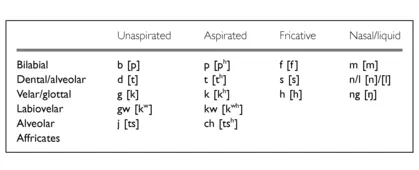![]()
Chapter 1
Phonology: the Cantonese sound system
The sound system of Cantonese is unfamiliar to speakers of European languages in several respects. Cantonese is a tone language in which the pitch or pitch pattern with which a syllable is pronounced is crucial to the identity of the word or syllable (1.4). The system of tones, with six distinctive pitch patterns, is also more complex than that of Mandarin. As in Mandarin, however, the possible combinations of sounds into syllables in Cantonese are restricted by comparison with European languages (1.3).
This chapter is intended to provide sufficient background information for the grammar to be used effectively, rather than to provide a phonological analysis of the Cantonese sound system. For fuller descriptions, see Chao (1947), Yue-Hashimoto (1972), K.-H. Cheung (1986) and Bauer and Benedict (1997).
In this chapter, sounds are represented using the Yale romanization system and when necessary using the International Phonetic Alphabet (IPA, shown in square brackets). See Appendix for the full listing of sounds in the Yale, IPA and Jyutping romanization systems.
1.1 Consonants
1.1.1 Initial consonants
There are sixteen initial consonants, i.e. those which may occur at the beginning of a word. These are shown in Table 1.1, according to their phonetic features.
The Cantonese stops and affricates pose considerable difficulty for the English speaker, because their distinctive features are different from those
Table 1.1 Initial consonants
of English. Whereas English stops such as p and b are distinguished by the contrast in voicing, p being voiceless and b voiced, no Cantonese stops are distinctively voiced. Rather, the contrast is one of aspiration – whether or not a burst of air is emitted immediately after oral release in the process of articulation. In English, this feature is also present in that initial p is normally aspirated and b not; however, this contrast is not a distinctive one. The result is that Cantonese b as in béi ‘give’ may be perceived by an English speaker either as p (because of the lack of voicing) or as b (because of the lack of aspiration). This combination of features – voiceless and unaspirated – in initial position is unknown in English, making the Cantonese series b/d/g difficult to recognize. Many romanization systems add to the difficulty by representing them as p/t/k respectively; this includes the romanization used in place names, so that Kowloon, for example, is pronounced by English h 1 speakers with an aspirated k [kh].1 In the Yale system it would be Gáulùhng, where the initial g represents an unaspirated voiceless velar stop [k].
The labiovelar consonants gw [kw] and kw [kwh] are coarticulated stops, i.e. the velar sound g or k is articulated simultaneously with the bilabial w, as in gwa ‘hang’ and kwàhn ‘skirt’. However, there is a tendency to simplify gw and kw to g and k respectively where they are followed by o or u, e.g. gwok ‘country’ is pronounced gok, sounding identical to gok ‘feel’. Similarly:
The simplified forms are used especially by younger speakers and in less formal speech (see 1.5). Note that the difference in pronunciation between kwu and ku, gwu and gu is a very slight one, as the lips are rounded similarly for the sounds w and u.
The alveolar affricates j and ch pose particular problems for learners and for romanization systems. Phonetically, j is [ts] which sounds similar to the final consonants at the end of the English word ads, but like the Cantonese stop d, it is pronounced without voicing. Its aspirated counterpart is ch [tsh] as in chàh ‘tea’, with strong aspiration, sounding similar to the ts in English tests. Both j and ch are pronounced with lips spread, rather than rounded as in English. The pronunciation of initial j, ch and s may be affected by the following vowel. In particular, for some speakers, the high front rounded vowel yu [y] tends to cause palatalization of j and ch to [t] and [ò ] respectively:
A similar palatalization affects s, which may become [∫] before yu:
The mid rounded vowel eu may also cause partial palatalization of these consonants, as in cheung ‘sing’, jeui ‘most’, séung ‘want’.2 The sounds resulting from this palatalization sound similar to the corresponding English affricates, as in church and judge. This pronunciation should not be used for j and ch throughout, however, as the palatalized variants will be very un-native-like if used before other vowels, as in jouh ‘do’ or chàh ‘tea’; such mispronunciations are in fact characteristic of English-speaking learners of Cantonese.
There are two semivowels which occur as initials:
y should be distinguished from the digraph yu as in syut ‘snow’ which represents the high rounded vowel. Similarly, initial w is distinct from the [w] sound which is part of the labiovelar consonants gw and kw: as noted above, these are coarticulated stops, in which the g/k and w sounds are formed simultaneously.
1.1.2 Unreleased consonants
In final position, i.e. at the end of a syllable, stops are
unreleased. For example, in
faat ‘law’, the
-t is formed by the tongue touching the alveolar ridge behind the upper teeth but without air being released.
In
ngaap ‘duck’, the lips are closed as for
p but not opened again, similar to the casual pronunciation of English
yep. Since unreleased consonants cannot be aspirated, the contrast between aspirated and unaspirated consonants is neutralized in this position. Also, the labiovelars
kw and
gw are not found in final position. Consequently, there are only three such unreleased stops:
-p ,
-t...





